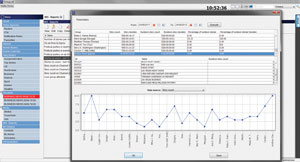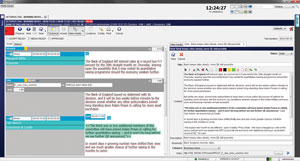The evolution of news
News is evolving. There is new technology in the newsroom and many more different types of consumers of live news. All this means that the newsroom computer system (NRCS) must evolve from the traditional TV-only model to one that can both make use of, and deliver to, a wider range of media platforms. There are new opportunities for mobile devices to contribute to news creation. At the same time, budgets are shrinking, and so the efficiency of both the equipment and labor required to run news production is also essential. The NRCS is a key part in the success of news production, and it spreads its tentacles in many directions. As a result, progress does necessarily affect the whole NRCS but is usually the result of many individual initiatives and additions that together enhance the product.
Requirements
The NRCS is only a part of the complex assembly of technology that produces the news, so it must interface efficiently with a wide variety of equipment and people. Variations not just in scale, but also in manning, hours of output, platforms, language and much more mean that each company’s news production requirement is different. In the middle, the NRCS must be able to handle all requirements efficiently and effectively as operation is usually near live or live, and any hiccup could easily put the news off the air.
NRCS history goes back decades to when modest computer power, by today’s standards, cost a fortune, and a large engineering and software effort was needed to produce a useful system. As a result, high costs have long been associated with NRCS, but it does not have to be that way. Today, a modern design that achieves the required results is not so much about leading-edge technology but providing what is right for each newsroom. Commercial off-the-shelf (COTS) computer hardware and well-designed software can provide a platform that is powerful enough to run an NRCS platform of any size and do so at a cost-effective price. Meeting the needs for a modern NRCS is more a question of having the flexibility and innovation to meet the particular requirements of each individual customer, including price.
Every NRCS is, of necessity, multifaceted and complex. However, its user interface has to be easy to learn and to operate. It must present just the information that each user needs and give access to required information in the form of text, stills and media. Ideally, it will have efficient interfaces with other relevant areas, including video editing and graphics. The majority of users are journalists, and it is essential that they feel absolutely comfortable at their screens as they work to meet deadline after deadline. At the same time, the user interface, and the technology behind it, must always be fast, even at the periods of high demand that typically occur before a bulletin.
Flexibility
Today, customers are able to choose from the wide range of NRCS available on the global market. It is not possible to build one fixed off-the-shelf news system to suit everyone, so a large degree of flexibility built into the design is essential. Then news broadcasters can get exactly the system they want.
The professional video industry's #1 source for news, trends and product and tech information. Sign up below.
Scale
No two NRCS systems are alike, as each is tailored to fit with a customer’s specific needs. Besides the choice of operating system, customers will require a certain size, a specific number of operating positions — seats. It should be able to successfully scale — from small, just a dozen seats, to big with hundreds — while always maintaining a low cost per seat and efficient workflow. This has advantages for both the supplier and user. It means the former can address the whole market with a practical product for all news workflows, and the latter can choose the required size and expand it later, if required. A large broadcaster can have several different sized installations at various locations all from the same NRCS provider that will then be familiar to its entire news staff.
Language
A manufacturer will, usually, first design its products with the local market in mind but, hopefully, will soon expand to export to other countries. Although one-third of the Earth’s population speaks English, two-thirds do not, and many would prefer to use their own language when working hard to meet the next deadline. Essentially, changing the language means altering the words in the menus. The structure of the menus need not change, but simply populating them with commands in the users’ own language is a significant step forward. Furthermore, the ability to define the language, not just for the whole NRCS, but also for individual users, allows operation in a mixed-language environment.
There may also be a requirement to output the news in more than one language. A way to achieve this with the minimum of additional effort is through the use of alternative scripts, where one story can have many scripts associated with it. Thus, all the NRCS data can be reused for each language’s bulletin.
Modular workflow
Today, many 24/7 news broadcasters make great savings by using modular workflows for news production, where content is often repeated. Fully implementing this into NRCS makes further savings. Modular workflows avoid the studio having to repeat live bulletins with the same material. By recording repeat items — such as the prompter text, video, voiceover, anchor scripts and graphics — parts or all of the bulletin can be replayed from the MCR. Going further, the various items that make up a bulletin — opening titles, introductions, voiceovers, graphics, interviews, etc. — can be scheduled, scripted, produced and recorded as and when they are available for production in the studio.
In the NRCS, this is then added to the pool, the story folder, and is immediately available to the rundown producer. This removes much of the stress of live broadcasting, making bulletin timing easier. It also leaves the studio and production control room free, keeping most, if not all, of the production facilities available for any new breaking stories as the rundown continues on-air, mainly played from the MCR.
Platform independence
There is always going to be pre-existing equipment and facilities such as stills stores, graphics, video editing as well as the traditional newswire services. It is most likely that these are file-based, and so it should be possible to integrate them with the NRCS. The most efficient way to achieve this is to have all elements running on the same type of platform, which, in practice, means being able to offer news systems working on Mac OS X, Windows or Linux platforms. Such platform independence makes basic integration easier and leads to a greater exchange of information between the components of the newsroom. In addition, further development for deeper integration with specific relevant products, such as media asset management (MAM), can deliver even greater efficiency.
MOS
The MOS news communication protocol allows integration with third-party systems. It gives the newsroom and the TV station a huge advantage in terms of flexibility as it can select each piece of the news system independently — provided that it supports MOS. This means they can select the best systems on the market to suit their needs and, thanks to common MOS protocol support, these systems will work together as a single package. MOS can also ease the transition to a new NRCS as other existing equipment that supports MOS can be plugged into the new NRCS and continue to be efficiently used.
Innovation
The business of making the news continues to evolve. Bringing new ideas to the process can provide new features, as well as enable the better use of existing resources.
MIS
A recent innovation is the introduction of a management information system (MIS) within an NRCS. With the aim of refining the workflow to provide the optimum use of resources, it allows managers to view the use of any chosen resource to get a picture of its use. The facility allows managers to set up reports that detail operations on selected aspects of the NRCS operation and deliver the required details back to the manager.

A recent innovation is the introduction of a management information system (MIS) within an NRCS. It allows managers to view the use of any chosen resource.
For example, such information could be used to identify any bottlenecks in the news workflow, or where there may be spare capacity. It could also be set to report the volume of resources used for each story, bulletin or day, the volume storage and output per story or department, or to report by topic, such as finance, sport, politics, etc. Such an MIS allows managers to get a picture of how the NRCS is used and may contribute to improved workflows and greater efficiency.
Tablet clients
The arrival of tablets has provided an opportunity to deliver targeted information from the NRCS to the studio floor and control room areas so that appropriate people receive live selected information that is a version of their normal NRCS screen views. This generates several types of tablet client each with easy, convenient access on the move to the live status of particular areas of operation that are forever changing as the news evolves.
For example, these could be the rundown, the anchor’s script and available media. When information in these areas is updated in the NRCS, so are the tablet views, keeping everyone everywhere in the studio up to date and in-step with the news.
More tentacles
The modern NRCS is connected in more ways than its predecessors; those tentacles have multiplied. The rise of new forms of communication means there are new ways to report the news and to receive it.
For example, a smart phone has many media capabilities and is connected via the mobile network. Adding a mobile client facility to the NRCS means it can integrate smart phones into the newsgathering workflow. This allows journalists anywhere to browse wires, create content and attach media such as video, images or sound. When finished, the story is sent to the NRCS.

The design of the user interface is key to ease of use by hard-pressed journalists.
Integration with social networking enables services such as Twitter, YouTube and Facebook to connect with the NRCS. The flow of information is bilateral. Reporters can publish posts outside the NRCS, as well as use online data as sources for their stories. A story-orientated workflow can enable journalists to work on a story, creating news scripts and posting onto social networks, all on one screen. The news also needs to go to the Web. So providing an easy way to deliver stories directly from the NRCS in pictures, text, video and audio to the TV channels’ website as a live update is now on the list of essentials.
What’s next?
We have just benefited from a torrent of new technology with mobile devices, tablets and more powerful COTS IT equipment. So it would be easy to think the pace of change in the newsroom will now slow. However, NRCS history indicates that advances never stop, and it seems likely that, in the short term, prime movers will continue to be the Internet and mobile devices. Further down the line, who knows? Whatever the future requirements are, a flexible, cost-effective and innovative NRCS will be well-placed to provide new requirements.
—Gabriel Jankó is sales director at OCTOPUS Newsroom.
